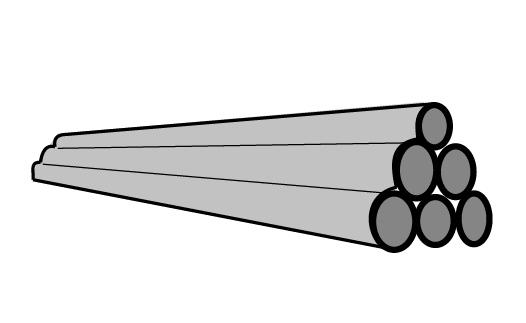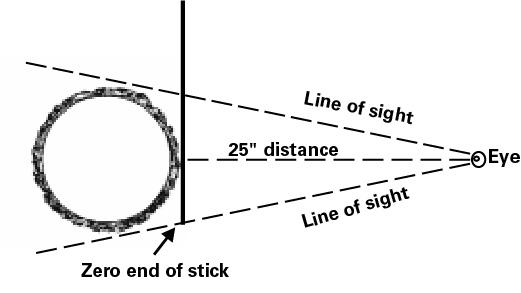The volume of wood in a tree and the type of product made from the wood are based primarily on the tree’s height and diameter. One of the basic tools for estimating the height and diameter of standing trees is a calibrated 25-inch scale stick, often referred to as a Biltmore stick or a cruiser’s stick. With practice, this instrument can be used to provide a reliable estimate of tree height and diameter, which then can be used to determine tree volume. This publication is for those interested in learning how to estimate tree volume and the type of product the tree may provide. For instructions on how to make your own scale stick, see “How to Make a Scale Stick” below.
If you want to estimate tree volume in order to sell timber, it is highly recommended that you consult a forester for advice. Volume alone does not determine value or the products that could be produced; tree quality is also very important. Forestry consultants can advise you on the types of wood products that could come from your timber as well as the quality of your timber. They also can provide you with estimates of the volume and value of the timber. In most cases the consulting forester’s experience with timber sales and knowledge of current markets can increase your revenues far in excess of the forester’s fees. For more information on consulting foresters, visit a N.C. Cooperative Extension county center or North Carolina Forest Service county office.
Product Types and Measurement Units
Major products that can be produced from pine trees include pulpwood, chip-n-saw, sawlogs, veneer logs (also known as plylogs), and pilings or poles. Major products produced from hardwood trees include pulpwood, sawlogs, and veneer logs (also known as grade or export logs). Each of these products must meet certain minimum size requirements (Table 1), and each varies in value based on the product, tree quality, and markets. For example, a tree 14 inches in diameter (measured 4½ feet above the ground) and with 50 feet of merchantable height can produce any one of three products that will vary in value based on the product (Table 2).
| Minimum Tree Size Characteristics | Volume Unit | Relative Value | ||
|---|---|---|---|---|
| Product | Pine | Hardwood | ||
| Pulpwood | >– 6” DBH to a minimum 3” top diameter | –> 6” DBH to a minimum 3” top diameter | cord | very low |
| Chip-n-saw | 9-14” DBH to a minimum 6” top diameter | not applicable | cord | low |
| Sawtimber | –> 14” DBH to a minimum 8” top diameter | >– 16” DBH to a minimum 10” top diameter | board foot | high |
| Veneer log | >– 16” DBH, clear/straight first log | >– 18” DBH, clear/straight first log | board foot | high |
| Pilings | various specifications based on local markets | not applicable | board foot | high |
| Potential Product | Volume | Relative Tree Value |
|---|---|---|
| Pulpwood | 0.23 cord | $3.00 |
| Chip-n-saw | 0.23 cord | $13.00 |
| Sawtimber | 145 board feet | $35.00 |
Standing trees or portions of trees sold for pulpwood or chip-n-saw are measured in cord volume. A cord is a stack of 4-foot long pieces of wood that is 4 feet high and 8 feet long; it includes 128 cubic feet of wood, bark, and air space.
Standing trees sold for sawlogs or veneer logs are measured in board-foot volume. A board foot is 1 inch thick, 12 inches wide, and 1 foot long. To determine the cord or board-foot volume of a tree, first measure the diameter and height using a scale stick. Check the diameter at a point 4½ feet above the ground (diameter breast height or DBH) on the uphill side of the tree and the merchantable height in increments of 16-foot and additional 8-foot logs. With these two measurements, you can determine the volume of the tree from various tree volume tables. Most scale sticks have the International ¼-inch, board-foot volume tables imprinted on them.
In North Carolina, pine sawtimber volume is often estimated using the Scribner log rule, and hardwood sawtimber volume is often estimated using the Doyle log rule. Tree volume estimates will differ based on which log rule is used because of differences in the way the estimates were formulated. Using the International ¼-inch rule as the basis for the volume, the Doyle log rule provides the lowest estimates for for trees up to 30 inches DBH, and Scribner provides intermediate estimates across all tree diameters (Figure 1). No matter which log rule is used to estimate volume, it is important to understand that timber prices also vary with log rules.
How to Make a Scale Stick
Materials
- a yardstick, 11⁄8 inches wide
- scissors
- paintbrush
- sandpaper
- rubber cement or a waterproof, clear household cement that adheres well
- varnish
Steps
- Download the NC State Extension Tree Estimate Stick template. Cut out the three paper forms.
- Glue Form 1 to the left edge of the yardstick, making sure that the left edge of Form 1 is even with the left end of the stick. The glue should be placed on the stick.
- Glue Form 2 to the stick. Make sure the left edge of Form 2 butts against the right edge of Form 1, which is marked by two arrows. The glue should be placed on the stick.
- Glue Form 3 to the stick by aligning the left edge of Form 3 with the right edge of Form 2, which is marked by two arrows. The glue should be placed on the stick.
- After gluing the three forms to the stick, trim and sand the corners of the stick so that the edges are smooth. Then cover the stick with clear water repellent (such as a clear varnish) to protect the stick during use.
Measuring Diameter
Tree diameter is the most important measurement of standing trees. Trees are measured 41⁄2 feet above ground-level, a point referred to as diameter breast height or DBH. Diameter breast height is usually measured to the nearest inch; but where large numbers of trees are to be measured, 2-inch diameter classes are used.
To measure DBH, stand squarely in front of the tree and hold the scale stick 25 inches from your eye in a horizontal position against the tree at 4½ feet above the ground. Shift the stick right or left until the zero end of the stick coincides with the left edge of the tree trunk. Without moving your head, read the measurement that coincides with the right edge of the tree trunk. This measurement is the tree’s DBH, including the tree’s bark (Figure 2). On sloping ground, measure from the uphill side. Two measurements at right angles to each other and averaged will give a more accurate reading since many trees are not perfect cylinders.
Measuring Merchantable Height
Merchantable height refers to the length of usable tree and is measured from stump height (1 foot above ground) to a cutoff point in the top of the tree. The cutoff height will vary with markets, with the product being produced, and with the presence of excessive limbs. The scale stick has been calibrated so that if you stand 66 feet from the tree being measured and hold the stick 25 inches from your eye in a vertical position, you can read the number of merchantable logs from the stick. It is important not to move the stick when taking a measurement; tilt your head back slightly so that you do not have to move your head when reading from stump point to cutoff height (Figure 3A and Figure 3B).
Estimating Volume
To estimate the board-foot volume of a tree using the volume table (International 1⁄4-inch rule) imprinted on the scale stick, you need an estimate of the tree’s DBH and merchantable height. With these two measurements, the board-foot volume of the tree is estimated by reading first the tree’s DBH and then the number of 16-foot logs (Figure 4). For example, a tree that is 10 inches DBH with a merchantable height of two 16-foot logs would have a volume of 60 board feet, International 1⁄4-inch rule. See the box below for instructions on converting to Doyle or Scribner.
Which Price Do You Use?
Timber prices per board foot vary, based on which log rule is used to estimate timber volume. Here are converstion factors for the various log rules:
Log Rule Converstions (Dollar Values)
| Doyle to Scribner Scribner to Doyle |
26% difference | 0.75 Doyle to Scribner 1.33 Scribner to Doyle |
| Doyle to International 1⁄4-inch International 1⁄4-inch to Doyle |
39% difference | 0.62 Doyle to International 1⁄4-inch 1.60 International 1⁄4-inch to Doyle |
| Scribner to International 1⁄4-inch International 1⁄4-inch to Scribner |
20% difference | 0.83 Scribner to International 1⁄4-inch 1.20 International 1⁄4-inch to Scrib |
For example: You know that pine sawtimber is selling for $300 per 1,000 board feet (Scribner log rule). What is the price equivalent for the International 1⁄4-inch log rule?
$300 per 1,000 board feet (Scribner log rule) x 0.83 = $249 per 1,000 board feet (International 1⁄4-inch log rule)
Things to Remember
- Seek professional forestry advice before selling your timber.
- The products that could be made from a tree vary based on minimum size requirements and tree quality.
- In general, product value increases with tree size.
- Timber prices differ, based on which log rule is used.
- Tree volume estimates vary, based on which log rule is used.
- When reviewing tree volume and prices, be sure that the price used to estimate value is for the log rule used to estimate volume.
- To ensure accuracy, hold the stick 25 inches from your eye when measuring.
- To measure tree height correctly, stand 66 feet from the tree.
Publication date: July 2, 2019
Reviewed/Revised: May 31, 2024
WON-05
N.C. Cooperative Extension prohibits discrimination and harassment regardless of age, color, disability, family and marital status, gender identity, national origin, political beliefs, race, religion, sex (including pregnancy), sexual orientation and veteran status.








